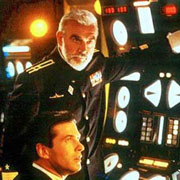VOA标准英语2011--Cold War Films Reflected Shifting US Attitudes(在线收听)
Cold War Films Reflected Shifting US Attitudes
In 1946 speech, British Prime Minister Winston Churchill coined the term “Iron Curtain” to describe the physical and symbolic wall separating East and West across Europe. Churchill's speech signaled the beginning of the Cold War.
It ended 20 years ago, with the dissolution of the Soviet Union in 1991. However, during the Cold War, American films reflected the changing mood of the United States towards the USSR.
Few movies have captured the history of early Communist Russia as well as David Lean’s “Doctor Zhivago.” The film was an epic love story between Yuri Zhivago and Lara, the wife of a communist leader. But it was also a bleak treatise on communist Russia.
Peter Rollberg, professor of film studies at George Washington University, says David Lean’s human treatment of Russians in "Doctor Zhivago" was the exception rather than the rule in Cold War films. “The Cold War created a field of tension that made for well-motivated good stories."
Some of these films, such as “The Manchurian Candidate,” explored the Communist threat on American soil. In the film, war hero Raymond Shaw is brainwashed into assassinating the president of the United States.
 |
| Sean Connery and Alec Baldwin in 1990's "The Hunt for Red October," which did not portray the Soviets as caricatures. |
At the time, Rollberg says, the film served as a warning to Americans. “The possibility of brainwashing, of the total manipulation of human beings, who will carry out whatever you charge them with, that was a warning that went beyond just the actual political situation. It meant, ‘society beware.'”
Stanley Kubrick’s “Dr. Strangelove" was released in 1964, two years after the Cuban missile crisis. A demented American Air Force general orders an unwarranted nuclear attack on the Soviet Union. The political satire reflected the nationwide terror of the nuclear holocaust.
The 1966 film “The Russians Are Coming, the Russians Are Coming” makes fun of the uncontrolled panic about the Soviets.
Meanwhile, the James Bond films gave espionage a Hollywood twist. Her majesty’s spy, 007, was a debonair playboy while the enemy was a fearless killing machine.
In the 1970s, films took a more conciliatory approach towards the Soviet Union, reflecting the era of détente. Two production companies, one American and one Soviet, worked together to produce the 1975 fantasy, “The Blue Bird," starring Elizabeth Taylor.
But the Soviet invasion of Afghanistan in 1979 and Ronald Reagan’s election as president the following year marked the end of détente.
Anti-Soviet rhetoric in film made a comeback. In the film "Rocky IV," the US-Soviet antagonism is reduced to the lowest common denominator - blood and brawn.
Rocky, played by Silvester Stalone, delivers the knock-out punch.
Soviet defections were also a popular theme in 1980s American filmography. In “Moscow on the Hudson,” Vladimir Ivanoff, a Russian musician played by Robin Williams, arrives in New York with a visiting circus troupe.
He defects in Bloomingdale’s, an icon of capitalism.
The attitude toward the Soviets changes again in the 1990 action film, “The Hunt for Red October,” made as the Soviet Union was in collapse. Sean Connery, as a Soviet submarine captain, turns his nuclear vessel towards American waters. The Americans need to decide whether he intends to defect or attack.
The Soviet captain is no longer a caricature; he's an intelligent human being.
Rollberg says the US audience had varied reactions to Cold War films. "On the commercial level, for many audiences, just as entertainment. On a more intellectual level, just looking at the consequences, and in a way at us, at humanity and what we are capable of.”
Robert Altman's film "Ready to Wear," showcases a post-Soviet Moscow as a fashionable place where people live life open to the world and all its possibilities.